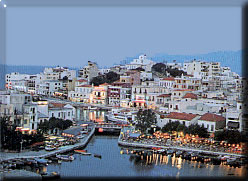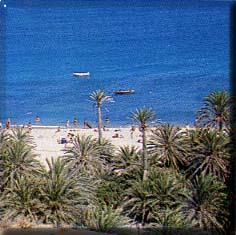
ISLANDS and
"
![]()
There are
the numerous islands of the Aegean sea.
Some are isolated in the
south like Crete with its mysterious history trough the centuries .Others,
in groups like the islands of the north-east Aegean, the Sporades,
the Cyclades and the Dodecanese. The Cyclades consist of 39
islands of which, only 24 are inhabited. The Sporades lie off the
eastern shores of mainland Greece and Euboea (Evia).
The vacation holidays are best
enjoyed with a nice sailing charter cruise rent a new yacht to
sail under the blue skies of aegean.
On all the islands, the
inhabitants retain their genuine island characteristics and
unchanged local traditions. The Dodecanese group consists of
twelve major islands with a number of smaller ones, each with its
own distinctive features and peculiarities.
Finally, there is the
Saronic Gulf which is the stretch of sea linking the shores of
Attica to those of the Peloponnese. Here, you can find another
group of islands which adds even more variety to the beautiful
surroundings.
Sailing the Aegean and
visiting the small ports, the quiet beaches is an experience you
will have only once in a lifetime.
(Details of chartering a
sailboat .CLIC)
Vegetation and
variations in climate are dependent on geographical regions.
The multiplicity of plants is exceptional with some 6,000
indigenous species having been recorded so far. Over 250 of these
flourish in Crete alone.
This impressive abundance of
flora and fauna arises from Greece's unique geographical location
between Europe and Africa.
The plants which
are associated with the joys of life can be seen in the countless
vineyards, which can be found throughout the country.
The trees are of medium
height and vary from pine, oak, fir, olive and mulberry trees to
citrus fruit and palm trees.
The climate
is for the most part, mediterranean with mild winters. The
subtropical, warm summers are cooled by a system of seasonal
breezes, popularly called the "Meltemia".
But the outstanding feature
of Greece's climate is the sunshine. On average, the sun
shines for 3,000 hours per year !
| CHARTERING PRICES | AEGEAN SAILING MAIN PAGE |
Crete
Land of Daidalos and Ikaros. Shining and starlit, with its black baggy breeches and fringed kerchiefs. Romantic Crete, with its sea, rocks and gleaming plateaus. Crete, land of full-bodied wine and pungent tsipouro. Crete, scented with wild fennel and fresh basil. Dizzying Crete, of the warlike dances. This island - the largest in Greece - separates the Aegean from the Libyan Sea, marks the boundary between Europe and Africa. Majestic mountains rise in its center - the White Mountains, Psiloritis, Dikti. Its plateaus are split by deep gorges and end up in fertile valleys.
The scenery is constantly changing. In one place harsh and barren, in another wooded and gentle. Its villages smothered in greenery.
Olive trees, orange groves, vineyards, early vegetable market gardens. Old stone farmhouses, monasteries and villages perched on mountain ridges, castles and chapels forgotten on steep slopes. Shores lined with forbidding rocks, often inaccessible, but also lots of endless sandy or pebbly beaches.
 Crete
is famous for the variety of its vegetation and the wildlife in
its chestnut, oak and cypress forests. Not to mention its palm
forests (at Vai and Preveli) and its cedar forests (at Gavdos and
Hrissi).
Crete
is famous for the variety of its vegetation and the wildlife in
its chestnut, oak and cypress forests. Not to mention its palm
forests (at Vai and Preveli) and its cedar forests (at Gavdos and
Hrissi).
Medicinal herbs and fragrant shrubs -
laudanum, dittany, marjoram and thyme - grow in rocky areas and
the mountain tops are home to the "kri-kri" or Cretan
goat.
The main cities-ports on Crete - Hania, Rethimno, Iraklio, Agios Nikolaos, Sitia- all grew up on the north side, which is more benign topographically. Ierapetra is the only port on the south coast, on the shores of the Libyan Sea, facing Africa.
This island's fertile soil and towering peaks witnessed the development of one of the most important civilizations on Earth, the Minoan (2800 - 1150 B.C.). In successive phase, the Minoans built palace-states - the famous palatial centers of Knossos, Phaistos, Malia, Zakros (1700 - 1450 B.C.). Their painters and ceramists show us the limits the refinement of art can reach.Their frescoes bring us close to the soul of that world, peace-loving, light-hearted, but also powerful. They bring us close to the sea and its wealth. A geological catastrophe - the eruption of the volcano of Santorini in 1450 B.C. - halted the Minoan civilization at its height. But life did not cease. Through shipping, commerce and trade with other peoples - the Phoenicians, Syrians, Egyptians - opened up new horizons. With the invasion of the Achaians and the Dorians on the island the new cities of Lato and Aptera were founded. Lato became the most important city on Crete (7th century B.C.). Until the Roman occupation (69 - 330 A.D.). The most distinguished center in those days was Gortyn. But Christianity came to the island early. During the Byzantine era the wealth of Crete was shown off in the mosaic floors of its basilicas and in half the churches of Greece. But many others had their eye on these riches. First Crete fell into the hands of the Arabs (824) for one and a half centuries (961). Handak, present-day Iraklio was founded. Then in 1204, the island passed to the Venetians. They fortified the old castles at Handak and built new ones at Gramvoussa, Spinalonga, Frangokastello, Ierapetra, Paleohora. They broke the ground for new cities (Hania and Rethimno) and built the fortifications essential to their defense. Inside the walls the cities developed with narrow, convoluted alleyways and small residential blocks, interspersed with decorative piazzas, fountains, churches and palaces, remains of which can still be seen today. Although the island was shaken from time to time by the rebellious populace, it continued to develop both economically and culturally. Painting and literature flourished. Domenicos Theotocopoulos (El Greco), Damaskinos and other iconographers painted exquisite portraits of the Virgin and Christ. Under the vaulted gates and arched windows troubadours passed singing ballads by Hortantzis about the suffering of Erotokritos and Erophili. In 1645 the Muslim conquerors set foot on the island for the first time. In 1669 the whole of Crete fell to the Turks. Not until 1913 was the island united with the rest of Greece.
 This
island with its clear, warm sea, boundless beaches lined with
tamarisks, splendid plateaus and mild starry nights has more to
offer than its past, its gorges, unskilled peaks and climate.
This
island with its clear, warm sea, boundless beaches lined with
tamarisks, splendid plateaus and mild starry nights has more to
offer than its past, its gorges, unskilled peaks and climate.
Today it continues to live
fully and to develop, its cities particularly changing in
appearance from one day to the next, in contrast to the many
unchanging villages where life goes on in the same rhythm it has
for centuries.
There are hundreds of
cafes where one can sit in the shade of a spreading plane, oak or
mulberry tree and sip a "sweat" or "medium"
coffee, or a glass of "tsikoudia" (raki) while playing
a game of cards or "tavli" (backgammon).
There are dozens of tavernas and ouzeries serving some tasty "meze", a specialty of the area. Yogurt and honey, sweet tarts (kaltzounia), pies made of wild greens flavored with fennel, fried cheese (staka), rabbit stew, cheese pie from Hora Sfakion, cockles, boiled goat. In the city of Hania, at Malaxa, at Vrisses, and other villages in the area, in Rethimno, in Iraklio and its villages, and in the whole district of Lassithi. Fish, sea urchins, octopus and cuttlefish cooked on charcoal and fried squid to be tasted at seaside tavernas.
And everywhere the delectable Cretan wine. Every saint's feastday is celebrated with gusto at dozens of villages throughout the island; all Crete throbbing to the sound of the Cretan lyre and the rhythm of the local dances, the pentozali and the sousta. Meanwhile the housewives are preparing a steamed Cretan pilaff and special holiday fritters (xerotigana).
In
the shop windows of bustling Iraklio, cosmopolitan Agios Nikolaos,
picturesque Rethimno, and Hania, elegant furs, precious jewelry
and artistic silverware attract the visitor's attention.
In the shops of lovely Sitia
and tranquil Ierapetra and in mountainous Anogia one is impressed
by the spread out patanies, traditional local woven fabrics in
dazzling colors, and everywhere one sees skillfully crafted
ceramics and leather goods. In the "Stivanadika"
district of Hania (Skridlof St.) traditional boots (stivania) are
still made in the old-fashioned way, because though it may seem
strange even today there are Cretans who still wear their
traditional costume.
In the marketplace of the
same city, the only one of its kind, but also in similar shops
all over the island, every kind of food, fruit and vegetable
produced in the fertile valleys, hot houses and mountain regions,
is laid out on display.
Exotic avocados, Belgian
endive and bananas, juicy oranges and fragrant melons, succulent
figs and tasty prickly pears, delicious grapes, sweet tomatoes,
tender cucumbers, fresh-watering sardines, tempting lobster, kid
from the islet of Gavdos, honey perfumed with thyme, and
wonderful cheeses - graviera (gruyere), myzithra (ricotta), fresh
white cheese, and soft, luscious staka. This is CRETE charter a sailboat and visit all around the
wonderful pearl of the Aegean.
![]() CHARTER
a 34,4 feet SAILBOAT CLICK HERE and PAY A VISIT to
the BOAT
CHARTER
a 34,4 feet SAILBOAT CLICK HERE and PAY A VISIT to
the BOAT
| Aegina,Hydra, Poros,Spetses |
Cyclades | SANTORINI |
Dodecanese
RHODES |
| CHARTER INFO | Weather | MYKONOS | HYDRA |